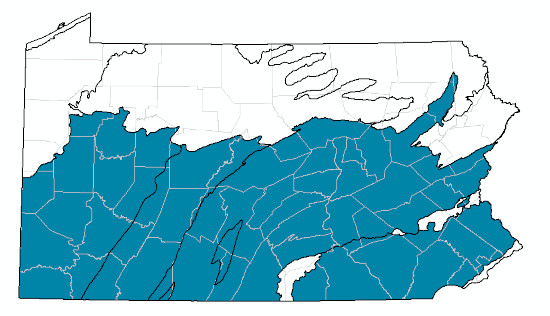Tuliptree – Beech – Maple Forest
System: Terrestrial
Subsystem: Forest
PA Ecological Group(s):
Appalachian-Northeast Mesic Forest
Global Rank:GNR
![]() rank interpretation
rank interpretation
State Rank: S5
General Description
The Tuliptree – Beech – Maple Forest is a mesic hardwoods forest type primarily of the Western Allegheny Plateau ecoregion. The canopy is similar to other northern hardwood forests with the tuliptree (Liriodendron tulipifera) being the most consistent tree species in the forest canopy. Red maple (Acer rubrum), sugar maple (A. saccharum), and American beech (Fagus grandifolia) are often codominant. The long list of possible associates includes various oaks, mostly red oak (Quercus rubra), as well as black-gum (Nyssa sylvatica), shagbark hickory (Carya ovata), bitternut hickory (C. cordiformis), sweet birch (Betula lenta), yellow birch (B. allegheniensis), and eastern hemlock (Tsuga canadensis; at less than 25% relative cover). White ash (Fraxinus americana) was once a substantial component of the forest overstory prior to the widespread devastation of this species by the emerald ash borer (Agrilus planipennis). Common shrubs include rosebay (Rhododendron maximum), ironwood (Carpinus caroliniana), flowering dogwood (Cornus florida), witch-hazel (Hamamelis virginiana), and spicebush (Lindera benzoin). There may be a rich herbaceous layer, especially in the vernal flora. On richer sites that are not over-browsed, this may include species like may-apple (Podophyllum peltatum), bloodroot (Sanguinaria canadensis), rattlesnake fern (Botrychium virginianum), Dutchman’s-breeches (Dicentra cucullaria), squirrel corn (D. canadensis), wild leek (Allium tricoccum), wild ginger (Asarum canadense), and spring-beauty (Claytonia virginica). This type may have different groundcover flora, depending on disturbance history. These forests often occur on fairly deep, not strongly acidic soils, at a mid-to lower-slope position. Soils are mostly medium acid to circumneutral silty clay, fine sandy, and silty loams.
Rank Justification
This type is common and widespread within the Western Allegheny Plateau ecoregion, where it exists as a matrix forest type; there are also occurrences in Maryland and New Jersey. This type often represents second-growth forests composed of common, relatively non-conservative species It is currently unranked by NatureServe (NatureServe 2022).
Identification
- Tuliptree-dominated forests in the Western Allegheny Plateau ecoregion
- Tree canopy is mainly tuliptree (Liriodendron tulipifera), American beech (Fagus grandifolia), yellow birch (Betula allegheniensis), black-gum (Nyssa sylvatica), and shagbark hickory (Carya ovata)
- Tree subcanopy includes ironwood (Carpinus caroliniana), dogwood (Cornus florida), and hophornbeam (Ostrya virginiana)
- Located on the mid- to lower slope on deep soils that are not strongly acidic Similar to other "northern hardwood" forests types: Rich Northern Hardwood Forest, Black Cherry Northern Hardwood Forest, and Red Oak – Mixed Hardwood Forest, but dominated by tuliptree.
- Black Cherry Northern Hardwood Forest and Red Oak – Mixed Hardwood Forests are similar but are dominated by black cherry and northern red oak (40% or greater within the canopy), respectively.
- The dominance of beech, tuliptree, and maple and the near-absence of heaths, such as teaberry (Gaultheria procumbens) and mountain laurel (Kalmia latifolia), distinguish these forests from the Western Allegheny Plateau Mixed Oak - Hardwood Forest.
Trees
Shrubs
Herbs
* limited to sites with higher soil calcium
Vascular plant nomenclature follows Rhoads and Block (2007). Bryophyte nomenclature follows Crum and Anderson (1981).
International Vegetation Classification Associations:
USNVC Crosswalk:None
Representative Community Types:
Beech - Tuliptree - Sugar Maple Forest (CEGL006296)
NatureServe Ecological Systems:
None
NatureServe Group Level:
Appalachian-Northeast Mesic Forest (G742)
Origin of Concept
Fike, J. 1999. Terrestrial and palustrine plant communities of Pennsylvania. Pennsylvania Natural Diversity Inventory. Pennsylvania Department of Conservation and Recreation, Bureau of Forestry, Harrisburg, PA. 86 pp.
Pennsylvania Community Code*
TM : Tuliptree – beech – maple forest
*(DCNR 1999, Stone 2006)
Similar Ecological Communities
The Tuliptree – Beech – Maple Forest is similar to other “northern hardwood” forests types: Rich Northern Hardwood Forest, Black Cherry Northern Hardwood Forest, and Red Oak – Mixed Hardwood Forest and considered to be in the same Alliance according to the NVC (USNVC 2019). Black Cherry Northern Hardwood Forest and Red Oak – Mixed Hardwood Forests are similar but are dominated by black cherry and northern red oak (40% or greater within the canopy), respectively. The dominance of tuliptree, beech, and maple and the near-absence of heaths, such as teaberry (Gaultheria procumbens) and mountain laurel (Kalmia latifolia), distinguish these forests from the Western Allegheny Plateau Mixed Oak - Hardwood Forest with which it shares a similar distribution. This type is often downslope of the dry oak-dominated ridges of the Western Allegheny Plateau. In much of the state, this type may be successional; as such, it may resemble other nearby communities, with tuliptree dominance resulting from past disturbance. The Tuliptree – Beech – Maple Forest is similar to the Successional Tuliptree Forest type in that both are dominated by tuliptree. However, the Successional Tuliptree Forest is described as a “ruderal” or “successional” forest type having established in abandoned pastures and agricultural fields. The Successional Tuliptree Forest is much less diverse and invasive plant species are much more common, especially multiflora rose (Rosa multiflora) and other species common in agricultural settings.
Fike Crosswalk
Tuliptree – beech – maple forest
Conservation Value
Threats
Beech bark disease is causing regional mortality of the American beech tree, and it is expected to infect the entire range of this species by 2025 (Stephanson and Coe 2017). Based on this prediction, it is likely the American beech will not be a primary component of this forest type in the near future. The beech component of this type is also threatened by beech leaf disease, a newly discovered, lethal sickness affecting beech trees, caused by an invasive nematode (Woleslagle 2022). White ash once made up a substantial proportion of the forest canopy of this type, especially on richer sites. Emerald ash borer eliminated much of the white ash component of the overstory.
Management
As with any terrestrial forest management, forest conditions at a given location may require a specific plan to achieve management goals. Private landowners can consult with service foresters at the Pennsylvania Bureau of Forestry for more information on sustainable forest management practices that are best suited for their property. Management of invasive species is encouraged. Also, management of white-tailed deer could improve hardwood regeneration in forests experiencing high rates of herbivory.
Research Needs
Potential range shifts (north) for hemlock, sugar maple, cherry, birch, and beech (Shortle et al. 2015, Bauer et al. 2016), all of which are components of the Tuliptree – Beech – Maple forest, could result in a change in distribution and abundance of this community type in a changing climate. Oaks or tuliptrees could replace some hardwood species in a changing climate. The relative abundance of oaks and tuliptree in Tuliptree – Beech – Maple forests should be assessed in contemporary examples of this community type to provide a baseline for oak and tuliptree occupancy in Pennsylvania forests. If tuliptree becomes more abundant, Tuliptree – Beech – Maple forests could become more common north of the Ridge and Valley, and in the Central Appalachians.
Trends
Tuliptree – Beech – Maple forests account for about 1% of mapped forested acreage on Bureau of Forestry and Pennsylvania Game Commission lands. The majority of this acreage is found in the Ridge and Valley and Central Appalachians. This area, however, is most likely more accurately representing the Successional Tuliptree Forest. The Tuliptree – Beech – Maple forest is thought to be successional and has increased in area of occupancy after disturbance events such as timber harvest. Furthermore, establishment of Successional Tuliptree Forests is common following agricultural abandonment.
Range Map

Pennsylvania Range
This community can be found in the following USEPA Level II Ecoregions: Piedmont, Ridge and Valley, Central Appalachians, and Western Allegheny Plateau.
Global Distribution
Pennsylvania, New Jersey, Maryland
Bauer, A., R. Farrell, and D. Goldblum. 2016. The geography of forest diversity and community changes under future climate conditions in the eastern United States. Ecoscience 23:41–53.
NatureServe. 2022. NatureServe Explorer [web application].
Shortle, J., D. Abler, S. Blumsack, A. Britson, K. Fang, A. Kemanian, P. Knight, M. McDill, R. Najjar, M. Nassry, R. Ready, A. Ross, M. Rydzik, C. Shen, D. Wardrop, and S. Yetter. 2015. Pennsylvania Climate Impacts Assessment Update. The Pennsylvania State University, University Park.
Stephanson, C. and Natalie Ribarik Coe. 2017. Impacts of Beech Bark Disease and Climate Change on American Beech. Forests 8:155.
USNVC. 2019. United States National Vegetation Classification Database, V2.03. Federal Geographic Data Committee, Vegetation Subcommittee, Washington DC.
Woleslagle, J. 2022, March 18. A Small Organism Causes Big Problems for Beech Trees. Good Natured: A look at the good things happening in PA’s natural places.
Cite as:
Braund, J., E. Zimmerman, A. Hnatkovich, and J. McPherson. 2022. Pennsylvania Natural Heritage Program. Tuliptree – Beech – Maple Forest Factsheet. Available from: https://www.naturalheritage.state.pa.us/Community.aspx?=16065 Date Accessed: November 01, 2025






